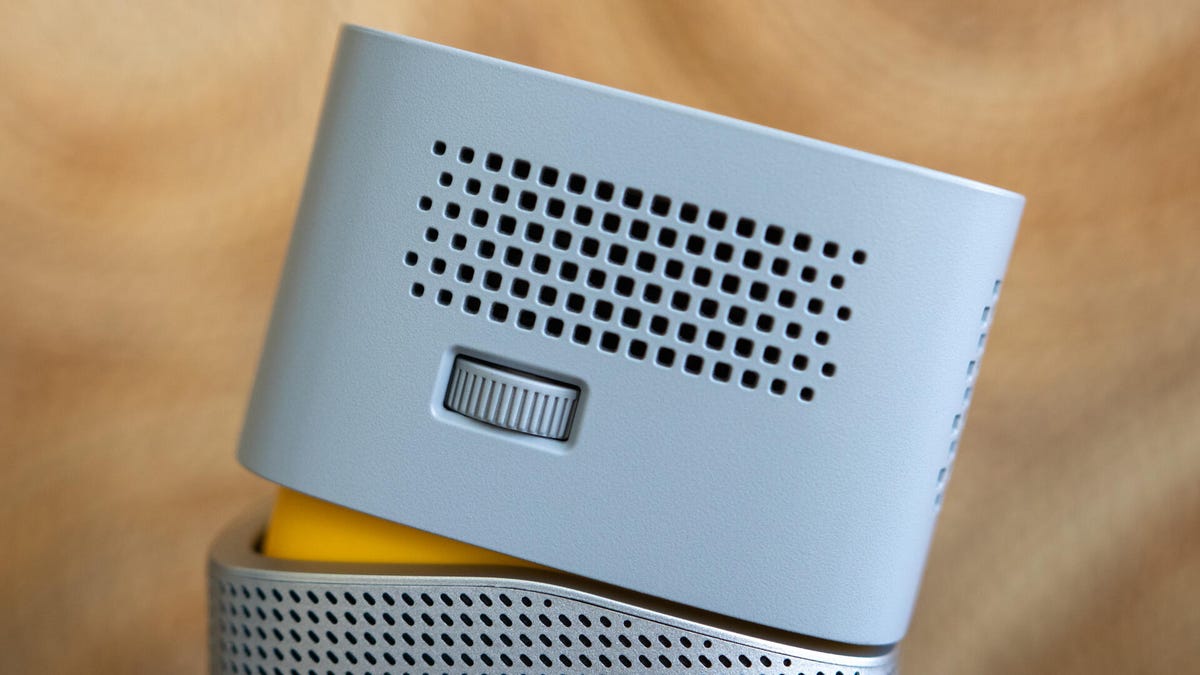 Why You Can Trust CNET
Why You Can Trust CNET BenQ GV1 review: Tiny portable projector will break your heart
It's inexpensive and cute, but the picture quality is anything but beautiful.
BenQ's GV1 portable projector looks like a robot you'd see in the background of a Pixar movie. Or in the real world, like a Bluetooth speaker. It's inexpensive, but its resolution is only standard definition and its image brightness is, well, not so bright. There isn't even a real HDMI input, though it does come with a dongle so you can connect HDMI sources. In short, this pipsqueak's design is pretty much the only reason to love it. It's so cute I couldn't help but introduce it to my Dōmo-kun -- they're roughly the same size at just 6 inches tall, and during my review period the two became fast friends.
Like
- Adorable
- Inexpensive and compact
- Did I mention adorable?
Don't like
- Low resolution
- Not very bright
- Weak built-in app store
I didn't have the heart to tell Dōmo how I really felt about the GV1. BenQ basically stuffed a bunch of aging tech into a tiny, adorable box. I like that there's a built-in battery, but the overall package is far outmatched by other portable projectors that cost just a bit more.
That disappointing picture quality, along with numerous usability issues I found during testing, made me want an updated version with upgraded internals and the same cute case design. As it stands now, the GV1 is hard to recommend even at its low price -- it's better to save up for something like the Anker Nebula Mars II Pro.
Basic specs
- Native resolution: 854x480 pixels
- HDR-compatible: No
- 4K-compatible: No
- 3D-compatible: No
- Lumens spec: 200
- Zoom: None
- Lens shift: Tilt only
- Lamp life (Normal mode): 20,000 hours
Only the least expensive projectors on the market today still have standard-definition resolutions. That 480p image manifests itself as massive pixels you can clearly see, even when creating smallish projected images. From all but the farthest viewing distances, the GV1 has the "screen door" effect that I haven't seen in the real projector world for at least a decade. If you're used to 1080p projectors or 4K TVs, the image from the GV1 is going to look like it's made from Lego.
The 200 claimed lumens is pretty low, though other battery-powered projectors like the Anker that have around 500 lumens are also more expensive. As long as you keep the image fairly small, it's fine.
Read more: From lumens to lens shift: 6 things to know before you buy a projector
The internal 3,000-mAh battery has a claimed 3-hour run time, but battery mode drops the lumens by about half.
There's no lens shift, but you can tilt the "head" backward to aim the image upward. This is actually quite an elegant solution and lets the GV1 fit better in tight spaces than many other projectors I've reviewed. That tilt also reveals the yellow highlights on the case, which look great.
The focus wheel, on the side of the head, is small, plastic and feels very cheap. Its tiny diameter makes it difficult to get precise focus.

Connectivity and convenience
- HDMI inputs: 1 (via included USB-C dongle)
- PC input: No
- USB port: 1 (the only input)
- Audio input and output: None
- Digital audio output: None
- Wi-Fi: a/b/g/n 2.4/5Ghz
- Remote: Not backlit
The biggest connectivity issue with the GV1 is the lack of a real HDMI input. Instead, it's got USB-C and includes a USB-C-to-HDMI dongle. This maxes out at 1080p30, potentially an issue since on many sources the default is 1080p60. Yes, in theory the source and projector should handshake and decide that 1080p30 works for everyone, but this reliance on HDMI handshakes to, well, work, is precarious.
There's a 5-watt speaker inside the small case, though it's a bit tinny and not particularly loud. The small remote is fine, though it's sometimes not enough to adequately navigate certain apps. Thankfully, the BenQ app (iOS and Android) works with the GV1 and has a keyboard.
The GV1's other liability is the Aptoide store, a "curated" subset of the Google Play store. Every time I've reviewed a projector with Aptoide I've been annoyed by it. It's not well laid out, many obvious apps are missing, and those you can find sometimes don't work. Spoiler alert! That was a big problem in this review, as you'll see.
While you can, in theory, mirror your phone's screen to the GV1, you can't watch copyrighted content in this way. So no Netflix, Hulu, Vudu etc from your phone. You'll need to get those apps, if you can find them. You can also connect a streaming stick, which we'll talk about in the next section.
The best-laid comparison plans
Now's the time in my reviews where I typically compare projectors. The Anker and LG are the two most obvious comparisons to the GV1. Both are small, portable, and have internal batteries. Their prices are in the same ballpark, as is their light output. I connected all three via a Monoprice 1x4 distribution amplifier, and viewed them all side-by-side-by-side on a 102-inch 1.0-gain screen.
At least, that was the plan. The GV1 doesn't accept a 1080p signal. Well, it does, but only 1080p30. And no matter what I tried, it just wasn't able to communicate that through the distribution amp to any source. I'm not sure if this is an issue you'll ever come across, since most of the time the source and display will agree on the best resolution and frame rate they're both able to produce. But it was an odd quirk I wanted to mention. So I ran the GV1 on its internal apps while the Anker and LG ran together from the D/A.
At least, that was the plan. I had the idea to start my testing with something on Disney Plus, since that was available on the BenQ, while the other two played the same movie on Vudu. On the BenQ the Disney Plus app loads, but when you try to log in, no keyboard shows up, nor does it show up in the smartphone Disney Plus app so Disney can "take it from there" as it says to do on the login screen. Not a problem. I downloaded the BenQ app, which conveniently has a keyboard to log in that way.
At least, that was the plan. Once entering my login info, there was an error message that said I needed to update my device's firmware. That's my first step in any review but I check again. Nope, I'm on the latest firmware. Not a problem. I switched it around to use the Vudu app on the BenQ and Disney Plus on the others.
At least, that was the plan. The Vudu app opens sideways, then crashes. Even better, it rotated everything else 90 degrees counterclockwise including the main homepage and other apps. Fortunately opening the settings flipped it back horizontal. So instead I used a different streaming stick, connected directly to the BenQ, to watch content that way.
At least, that was the plan. The Vudu app nuked the GV1. Every few seconds the app would try to reopen, flipping the screen sideways, crashing, and then dropping back to the now-sideways main homepage. This loop continued even after restarting the GV1. I consider drop testing the GV1 from progressively greater heights starting with Jupiter.
I succeed in deleting the cancerous app. I succeed in switching to the external streaming stick. The other projectors have gone to sleep. The world is asleep. The universe has cooled into entropic nothingness.
But I have an image! On all three projectors! Let's get this party started. This thing is gonna be great!
Picture quality comparisons (finally!)
The GV1 is not great. It can best be described as "fine." Resolution is a good place to start, which, ironically, is not fine. I can't remember the last display I reviewed that wasn't HD. For the BenQ's price and size, I don't think 480p is a deal breaker, but if you're used to watching HD or 4K, the image from the GV1 is going to look soft. You don't need to sit very close, or make the image very large, to see big honking pixels either. Side by side with the LG, with the same size image and sitting just far enough that pixels aren't visible, the LG looks noticeably more detailed.
Despite having very similar light output and contrast ratio numbers, the BenQ looks flatter and more washed out than the LG. Knowing that they measure so similarly, I wonder how much closer I'd have been able to dial in the BenQ had there been any picture controls at all. Just some generic picture modes, but no adjustment for contrast, brightness, or color/tint.
Colors however, are surprisingly accurate. At least, more accurate than most other budget projectors. That seems to be BenQ's thing.
Occasionally, the GV1 would start dropping frames, causing the image to look juddery. I'm not quite sure what caused this, but unplugging the source and plugging it back in seemed to fix it.
Across all content, the LG just looked a little better, and while it's a bit more money, the brighter Anker blows it away.
There is one other projector I want to mention. If you're looking for something for occasional movie nights, but don't need a battery, you can get a lot better performance in a more traditional home projector, even for similar money. The Optoma HD146X, for example, is more than twice as bright as the Anker, for the same price. If you use a brighter mode you get slightly worse color accuracy, but an even brighter image. Check out some more options in our Best Projectors for 2020 guide.
Conclusion
I wanted to love the GV1. It looks like something out of a Pixar movie. Its performance isn't great, but it's also not very expensive. However, there are too many oddities to offset its looks. For a bit more money the Anker Mars II Pro is just an easier to use portable projector and has the added benefit of being brighter, higher resolution and with better speakers.
As well as covering TV and other display tech, Geoff does photo tours of cool museums and locations around the world, including nuclear submarines, massive aircraft carriers, medieval castles, airplane graveyards and more.
You can follow his exploits on Instagram and YouTube, and on his travel blog, BaldNomad. He also wrote a bestselling sci-fi novel about city-sized submarines, along with a sequel.


